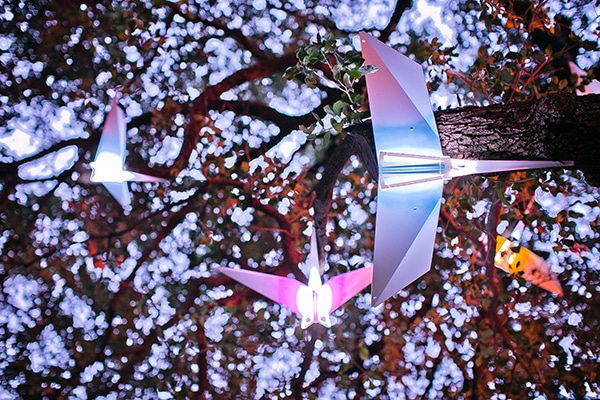Editor’s note: This post was excerpted from Lina Dib’s artist talk on November 21 at Discovery Green. Here and Now is presented in conjunction withPalomaSponsored by PNC Bank and is on display through February 24. Sneak peeks, artist talks and more are all benefits of Forever Green memberships. To become a member visit discoverygreen.com/membership. To learn more about Lina Dib and her work, visit linadib.com.
Until the 19th century, there were all kinds of theories to explain why birds seemed to disappear for part of the year. Aristotle believed that some birds hibernated, or turned into other species. In medieval Europe barnacle geese were believed to grow on trees since goose barnacles (the crustaceans) often grow on driftwood in the sea and resemble their aviary namesake. Cartographers in the 16th century believed some birds buried themselves at the bottom of rivers. A 17th century English minister and scientist theorized that birds flew to the moon.
Undeniable proof that birds migrated came in 1822 when a German hunter shot down a white stork with an arrow stuck in its neck. This iron-tipped arrow was from Central Africa and provided evidence of where storks actually spent the winter.
Around this time, farmer and amateur naturalist Johann Naumann noticed caged migratory birds would flutter anxiously and show signs of shifting sleep patterns around the time other birds of their species were beginning to migrate. Zugunruhe then became a word used to describe a certain kind of restlessness animals exhibit when they feel the compulsion to migrate.
My sonic triptych reflects on this observed urge to move. Part 1 of the triptych, titled North to South and Back focuses on migration in Houston and the surrounding regions in particular. Part 2, There Is No Going Back is about loss, memory and reflection and features sounds of endangered and extinct species as well as sounds of outer space. This last part, Here and Now, is about resilience and also features birds that migrate through other parts of the world. It gestures to global connections across vast distances. The compositions that make up this piece also include a kind of call and response in the form of bird sounds made by human immigrants to Houston. They point to Houston’s diversity and highlight various ways that life on earth is marked by, and even sustained by, movement.
A few fun facts about some of the migratory birds featured in Here and Now:
- When birds migrate, they use the sun, the moon and other celestial bodies, as well as the earth’s magnetic field, to navigate.
- Some migratory birds have magnetic minerals like iron in their beaks that help them navigate, or a particular protein in their eyes that help them “see” magnetic fields.
- Sandhill Cranes, featured in the piece, mate for life, which can mean two decades or more, and they stay with their mates year-round.
- Blackburnian Warblers migrate more than 600 miles across the Gulf of Mexico each spring, a flight that takes them over 15 hours non-stop.
- The Bar-tailed Godwit flies from Alaska to New Zealand and holds the record for the farthest non-stop flight of any bird, flying for over 6500 miles without rest. I am blown away by their endurance.
- Some migratory birds have micro-naps while flying, something I have been trying out lately.
- The Arctic Tern breaks the record for distance, flying pole to pole every year. Over its 30-year life span, it flies the equivalent of to the moon and back three times!
But Zugunruhe, or “the urge to move,” isn’t the only force driving populations to traverse perilous distances in order to thrive. Many species are in decline due to climate change, habitat encroachment and deforestation. These changes create dangerous conditions and shift migratory patterns. According to a study that came out in Science in September, and that many of us are familiar with now, North American skies are quieter than they were in the 1970s. Over the last 50 years, North America has lost nearly 3 billion birds. That’s about 30% of our birds.
Acting as a ghost in the system and sentinel for the future, the song of an extinct bird also joins the choruses of migrating birds and humans in each part of this sonic triptych. This bird is a Kauai ‘O’O recorded circa 1987. It was recorded by the Cornell Ornithology lab. This Kauai ‘O’O was the last of its species singing for a mate that would never come. His song is flute-like and haunting and is a gentle but poignant warning siren.
Although I feature the sounds of many amazing birds in this sonic triptych, my work is not about a perfect representation of nature or in this case, a perfect portrait of these birds. In some moments Siddharth, an eight-year-old birder who knows more about birds than any adult I have met, tells the audience what they are hearing (à la sir David Attenborough), but in other moments, I very explicitly manipulate the sounds and movement of the sounds. At times, they are barely recognizable. The notes or musical parts in the piece, for instance, are made using some of the bird sounds themselves through a process called granular synthesis. In other words, I use nature as raw material. The composition is a kind of sculpture as well as a detailed choreography, a staged encounter.
Instead of sound effects, I like to say that I work with sound affects. The piece oscillates between epic moments, and more quiet gentle ones. It also feels serious and occasionally humorous. Birds are cute and funny. They are also epic and inspiring, and humans, of course, can be all of these things.
One of the affects or dispositions I want to encourage with Here and Now is one of attention and care. I want the work to encourage people to slow down. In this busy world I think it’s important to teach ourselves to slow down or even to stop, to dwell for a while and to do nothing. By tuning-out we can better tune-in to our surroundings. Maybe, in a sense, this call to inaction will stir different kinds of actions, more careful and caring ones.
In short, by bringing together technology and field recordings, whether visual or auditory, and by bringing together research and creation, I amplify the spectacles of nature. I notice birds a lot more now and I hope others will too. They can tell us a lot if we learn to listen.
Additional reading:
Bird that solved migration mystery now illegally killed on its journey
How Houston can help migratory birds
The Bar-tailed Godwit’s Annual Migration Is Utterly Astounding
3 billion North American birds have vanished since 1970, surveys show



